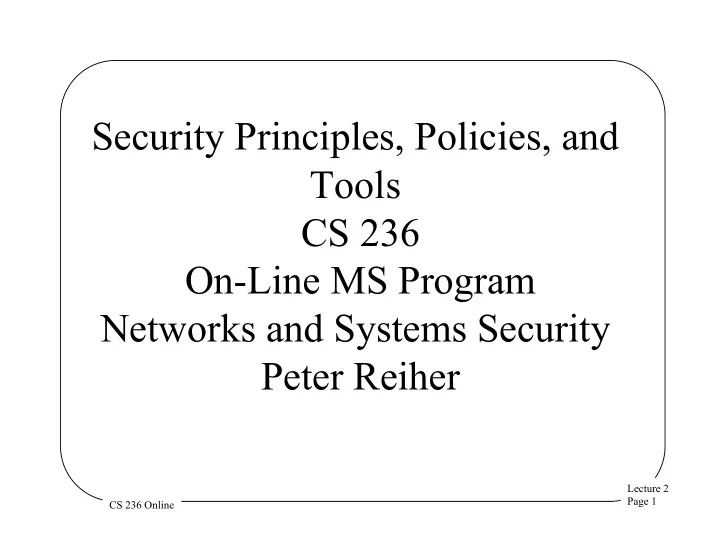

Security Principles, Policies, and Tools CS 236 On-Line MS Program Networks and Systems Security Peter Reiher Lecture 2 Page 1 CS 236 Online
Outline • Security design principles • Security policies – Basic concepts – Security policies for real systems • Classes of security tools – Access control Lecture 2 Page 2 CS 236 Online
Design Principles for Secure Systems • Economy • Complete mediation • Open design • Separation of privileges • Least privilege • Least common mechanism • Acceptability • Fail-safe defaults Lecture 2 Page 3 CS 236 Online
Economy in Security Design • Economical to develop – And to use – And to verify • Should add little or no overhead • Should do only what needs to be done • Generally, try to keep it simple and small Lecture 2 Page 4 CS 236 Online
Complete Mediation • Apply security on every access to a protected object – E.g., each read of a file, not just the open • Also involves checking access on everything that could be attacked Lecture 2 Page 5 CS 236 Online
Open Design • Don’t rely on “security through obscurity” • Assume all potential attackers know everything about the design – And completely understand it • This doesn’t mean publish everything important about your security system – Though sometimes that’s a good idea • Obscurity can provide some security, but it’s brittle – When the fog is cleared, the security disappears – And modern attackers have good fog blowers Lecture 2 Page 6 CS 236 Online
Separation of Privileges • Provide mechanisms that separate the privileges used for one purpose from those used for another • To allow flexibility in security systems • E.g., separate access control on each file Lecture 2 Page 7 CS 236 Online
Least Privilege • Give bare minimum access rights required to complete a task • Require another request to perform another type of access • E.g., don’t give write permission to a file if the program only asked for read Lecture 2 Page 8 CS 236 Online
Least Common Mechanism • Avoid sharing parts of the security mechanism – among different users – among different parts of the system • Coupling leads to possible security breaches Lecture 2 Page 9 CS 236 Online
Acceptability • Mechanism must be simple to use • Simple enough that people will use it without thinking about it • Must rarely or never prevent permissible accesses Lecture 2 Page 10 CS 236 Online
Fail-Safe Designs • Default to lack of access • So if something goes wrong or is forgotten or isn’t done, no security lost • If important mistakes are made, you’ll find out about them – Without loss of security – But if it happens too often . . . Lecture 2 Page 11 CS 236 Online
Thinking About Security When considering the security of any system, ask these questions: 1. What assets are you trying to protect? 2. What are the risks to those assets? 3. How well does the security solution mitigate those risks? 4. What other security problems does the security solution cause? 5. What tradeoffs does the security solution require? (This set of questions was developed by Bruce Schneier, for his book Beyond Fear ) Lecture 2 Page 12 CS 236 Online
Recommend
More recommend